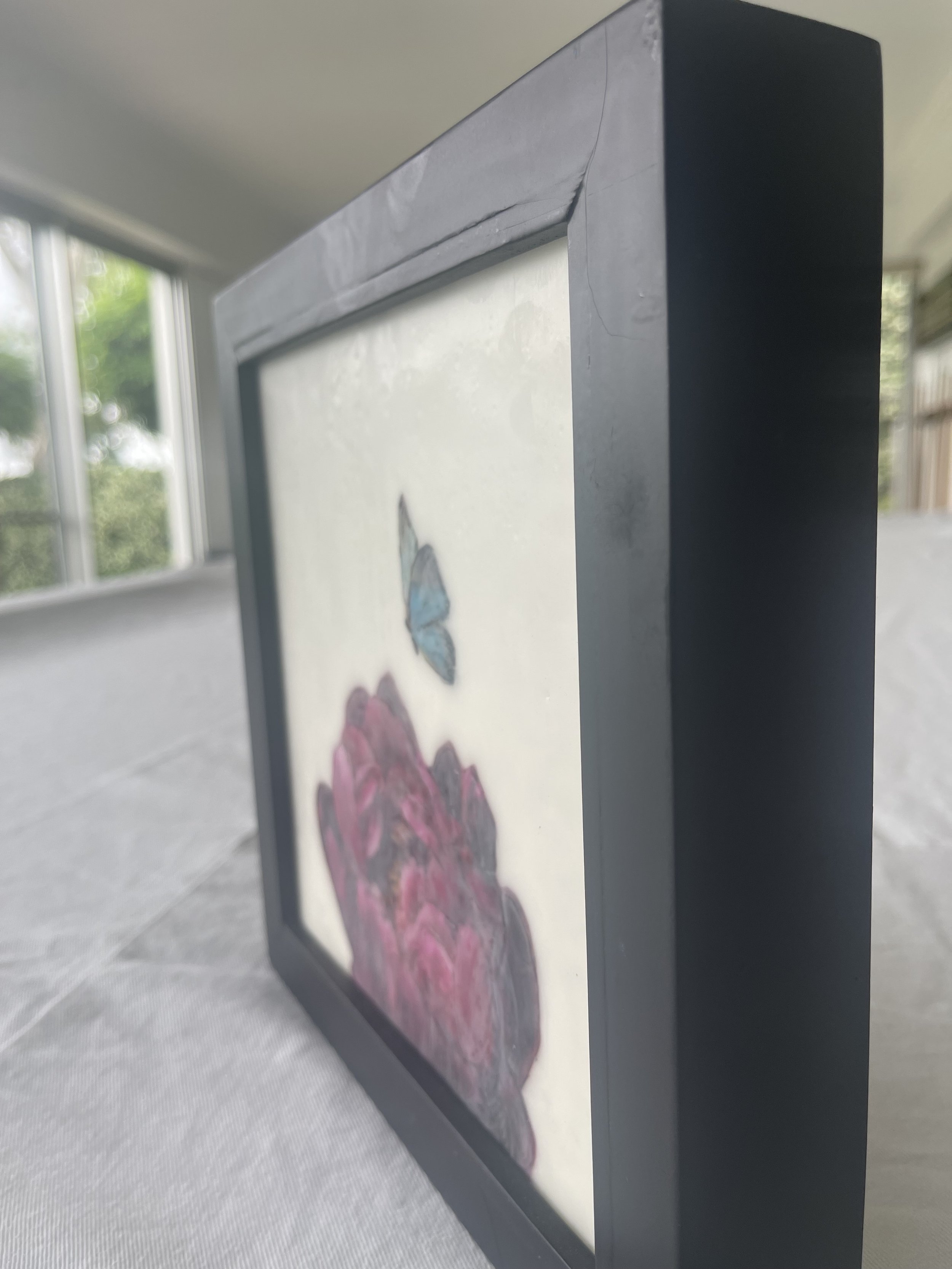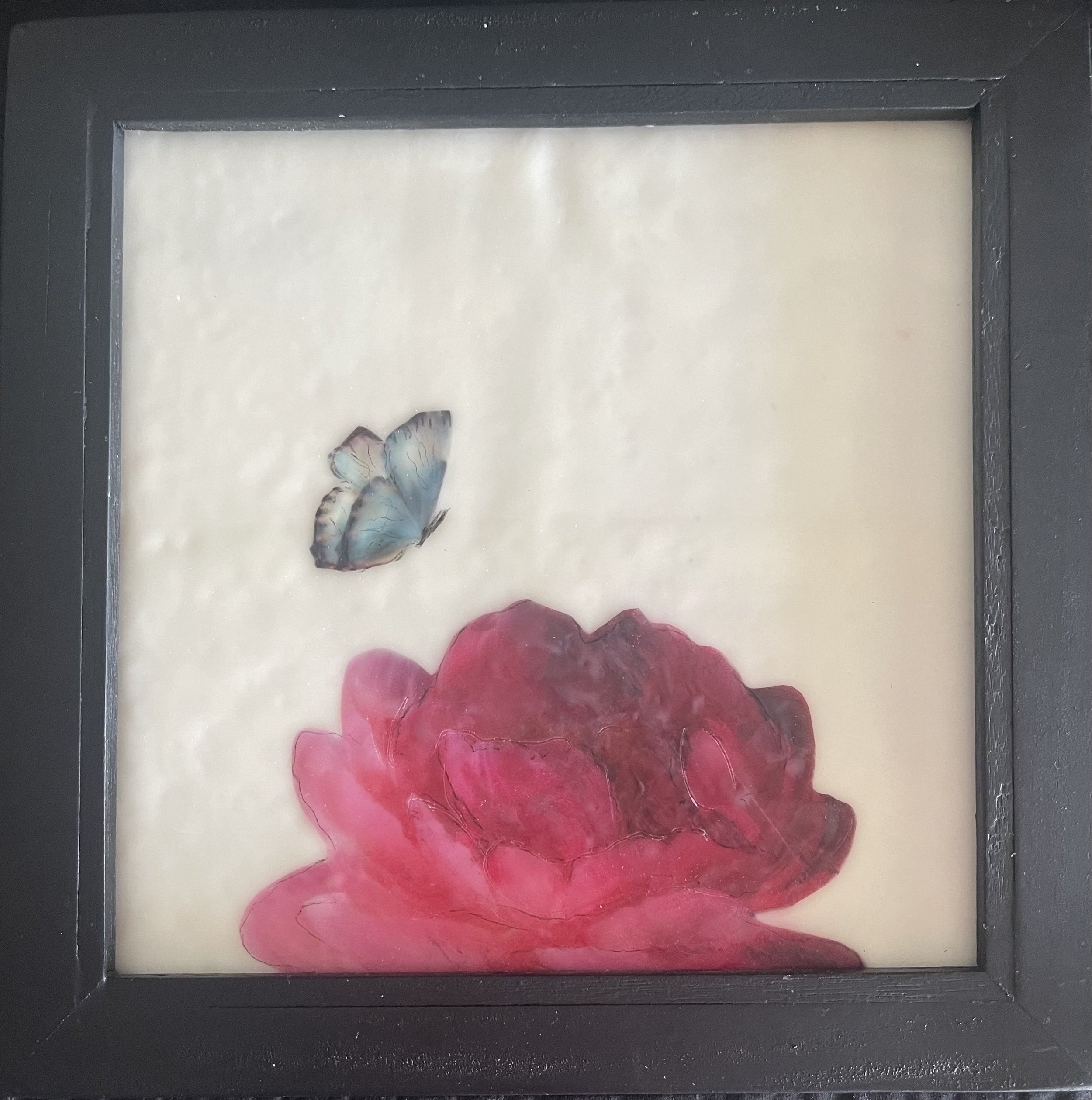





Butterfly landing #2
"Welcome to 'Butterfly Landing #2'! This charming mixed media and encaustic wax artwork captures a moment of serenity and grace. A plump burgundy-colored peony at the center, delicately portrayed with hues that evoke warmth and delicacy and is textured and etched. Hovering above is a blue butterfly, seemingly suspended in mid-air as it prepares to land. The piece, measuring 24 cm x 24 cm, is framed in a black frame. Let yourself be drawn into this tranquil scene where nature's beauty comes to life in a harmonious blend of colors and textures."
Encaustic painting is an ancient art form and can be traced back to the 5th century BC. Encaustic wax is a combination of beeswax and an additive to strengthen and raise the melting temperature. Typically damar resin is used though other additives are sometimes used. Layers of molten wax are applied to wooden structures/panels. It has beautiful luminous qualities which can be coloured. The wax can be embedded, collaged, scraped, textured and polished to a high sheen. Encaustic wax is a natural adhesive and preservative, it is moisture resistant, mildew and fungus resistant and unappetising to insects. Wax paint doesn’t contain solvents or oils so will not darken or yellow with age, it is 100% archival.
Care for Encaustic Wax
Encaustic paint is the most durable form of painting, evidenced by the Faiyum mummy portraits in Egypt. They have survived over 2000 years without cracking, flaking or fading.
Do not hang fine art in direct sunlight, encaustic wax in particular should always feel cool to touch. Encaustic wax is stable from 4 - 49 degrees C. Use a soft lint free cloth to gently buff if it becomes dull looking, this happens during curing time (around 6 months) It should always look shiny. After that time it will retain it’s polished look. At this point it will repel dirt and dust more readily.
Properly looked after your Encaustic wax painting will last many life times.
Butterfly landing #2
"Welcome to 'Butterfly Landing #2'! This charming mixed media and encaustic wax artwork captures a moment of serenity and grace. A plump burgundy-colored peony at the center, delicately portrayed with hues that evoke warmth and delicacy and is textured and etched. Hovering above is a blue butterfly, seemingly suspended in mid-air as it prepares to land. The piece, measuring 24 cm x 24 cm, is framed in a black frame. Let yourself be drawn into this tranquil scene where nature's beauty comes to life in a harmonious blend of colors and textures."
Encaustic painting is an ancient art form and can be traced back to the 5th century BC. Encaustic wax is a combination of beeswax and an additive to strengthen and raise the melting temperature. Typically damar resin is used though other additives are sometimes used. Layers of molten wax are applied to wooden structures/panels. It has beautiful luminous qualities which can be coloured. The wax can be embedded, collaged, scraped, textured and polished to a high sheen. Encaustic wax is a natural adhesive and preservative, it is moisture resistant, mildew and fungus resistant and unappetising to insects. Wax paint doesn’t contain solvents or oils so will not darken or yellow with age, it is 100% archival.
Care for Encaustic Wax
Encaustic paint is the most durable form of painting, evidenced by the Faiyum mummy portraits in Egypt. They have survived over 2000 years without cracking, flaking or fading.
Do not hang fine art in direct sunlight, encaustic wax in particular should always feel cool to touch. Encaustic wax is stable from 4 - 49 degrees C. Use a soft lint free cloth to gently buff if it becomes dull looking, this happens during curing time (around 6 months) It should always look shiny. After that time it will retain it’s polished look. At this point it will repel dirt and dust more readily.
Properly looked after your Encaustic wax painting will last many life times.






















